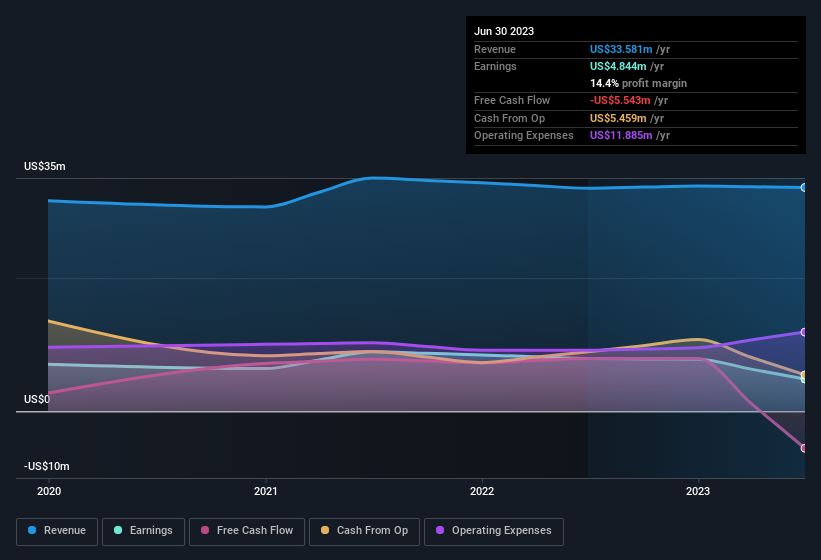- United States
- /
- Professional Services
- /
- NasdaqCM:LICN
Weak Statutory Earnings May Not Tell The Whole Story For Lichen China (NASDAQ:LICN)

A lackluster earnings announcement from Lichen China Limited (NASDAQ:LICN) last week didn't sink the stock price. However, we believe that investors should be aware of some underlying factors which may be of concern.
Check out our latest analysis for Lichen China

A Closer Look At Lichen China's Earnings
One key financial ratio used to measure how well a company converts its profit to free cash flow (FCF) is the accrual ratio. To get the accrual ratio we first subtract FCF from profit for a period, and then divide that number by the average operating assets for the period. You could think of the accrual ratio from cashflow as the 'non-FCF profit ratio'.
As a result, a negative accrual ratio is a positive for the company, and a positive accrual ratio is a negative. That is not intended to imply we should worry about a positive accrual ratio, but it's worth noting where the accrual ratio is rather high. Notably, there is some academic evidence that suggests that a high accrual ratio is a bad sign for near-term profits, generally speaking.
Over the twelve months to June 2023, Lichen China recorded an accrual ratio of 0.39. As a general rule, that bodes poorly for future profitability. To wit, the company did not generate one whit of free cashflow in that time. In the last twelve months it actually had negative free cash flow, with an outflow of US$5.5m despite its profit of US$4.84m, mentioned above. We saw that FCF was US$7.9m a year ago though, so Lichen China has at least been able to generate positive FCF in the past. The good news for shareholders is that Lichen China's accrual ratio was much better last year, so this year's poor reading might simply be a case of a short term mismatch between profit and FCF. As a result, some shareholders may be looking for stronger cash conversion in the current year.
Note: we always recommend investors check balance sheet strength. Click here to be taken to our balance sheet analysis of Lichen China.
Our Take On Lichen China's Profit Performance
As we have made quite clear, we're a bit worried that Lichen China didn't back up the last year's profit with free cashflow. For this reason, we think that Lichen China's statutory profits may be a bad guide to its underlying earnings power, and might give investors an overly positive impression of the company. Sadly, its EPS was down over the last twelve months. Of course, we've only just scratched the surface when it comes to analysing its earnings; one could also consider margins, forecast growth, and return on investment, among other factors. If you'd like to know more about Lichen China as a business, it's important to be aware of any risks it's facing. For instance, we've identified 5 warning signs for Lichen China (3 are a bit concerning) you should be familiar with.
Today we've zoomed in on a single data point to better understand the nature of Lichen China's profit. But there is always more to discover if you are capable of focussing your mind on minutiae. For example, many people consider a high return on equity as an indication of favorable business economics, while others like to 'follow the money' and search out stocks that insiders are buying. So you may wish to see this free collection of companies boasting high return on equity, or this list of stocks that insiders are buying.
New: AI Stock Screener & Alerts
Our new AI Stock Screener scans the market every day to uncover opportunities.
• Dividend Powerhouses (3%+ Yield)
• Undervalued Small Caps with Insider Buying
• High growth Tech and AI Companies
Or build your own from over 50 metrics.
Have feedback on this article? Concerned about the content? Get in touch with us directly. Alternatively, email editorial-team (at) simplywallst.com.
This article by Simply Wall St is general in nature. We provide commentary based on historical data and analyst forecasts only using an unbiased methodology and our articles are not intended to be financial advice. It does not constitute a recommendation to buy or sell any stock, and does not take account of your objectives, or your financial situation. We aim to bring you long-term focused analysis driven by fundamental data. Note that our analysis may not factor in the latest price-sensitive company announcements or qualitative material. Simply Wall St has no position in any stocks mentioned.
About NasdaqCM:LICN
Lichen International
An investment holding company, provides financial and taxation, education support, and software and maintenance services in the People’s Republic of China.
Adequate balance sheet slight.
Market Insights
Community Narratives



